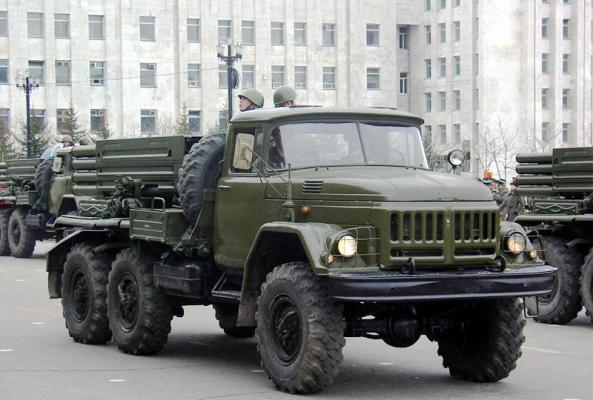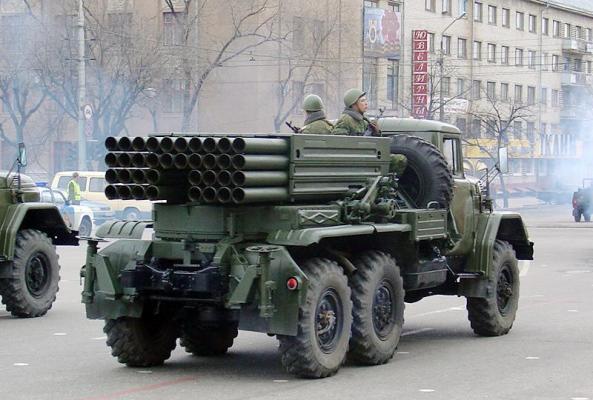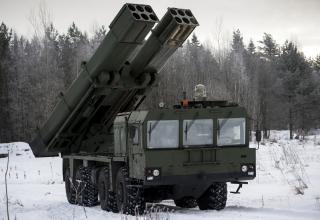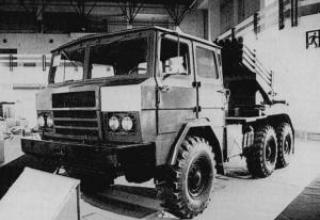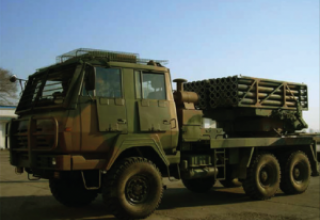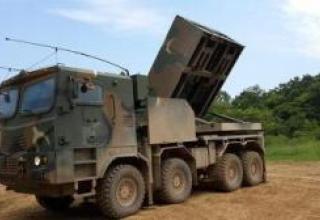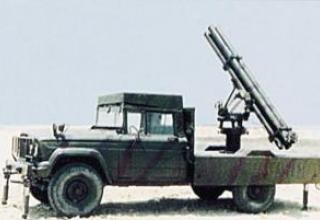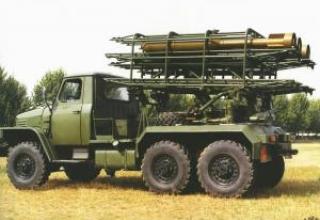The 9K55 "Grad-1" regimental multiple launch rocket system (MLRS) is designed to engage the enemy's manpower and materiel in areas of concentration, artillery and mortar batteries, command posts and other targets directly on the front line.
The 9K55 "Grad-1" RSZO is designed on the basis of the M-21 division level field rocket system and is intended for arming artillery units of motorized rifle regiments and marine infantry regiments.
Due to the need to create a regimental multiple launch rocket system with a firing range of X=15 km and the creation of a combat vehicle for the division system, which meets the requirements of the PAZ (anti nuclear protection), PCH (chemical protection), PBZ (antibacterial protection), In 1965-1968, the Tula State Research Institute of Precision Machine Building (TGNIITM, TulgosNIItochmash) conducted a proactive search work to determine the possibility of creating a regimental multiple launch rocket system with a range of fire up to 15 km ("Grad-1") and a divisional multiple launch system with a range of fire up to 24 km ("Grad-2"). In order to increase the effectiveness of the systems, fragmentation warheads have been developed. That is, new, more advanced solutions in the missile area have been taken into account in design work.
A tracked MT-LB (2C1) chassis for the Grad-1 and Grad-2 rocket systems and a ZIL-131 wheeled chassis for the Grad-1 rocket system were offered as chassis for combat vehicles. The combat vehicle was to provide attachment of removable guides or swinging part of the combat vehicle BM-14 and launch of M-14OF rounds.
By letter 1-3342ss dated June 29, 1966, the 1st Main Directorate of the USSR Ministry of Defense reported that the General Staff of the Soviet Army put forward the development work "Grad-1" for execution. The execution of this work was entrusted to the enterprise p/o R-6760.
The basis for the development of the regimental multiple launch rocket system "Grad-1" was the Resolution of the Council of Ministers of the USSR dated January 21, 1970, No.71-26. The main developer was the Ministry of Mechanical Engineering, General Customer at an hour 64176. The composition of the complex: Fighting Machine 9P138, Fighting Machine 9P143, Fighting Machine 9P139, Fighting Machine 9P144, Transport Machine 9T450, Transport Machine 9T451, Transport Machine 9T450-01, Shots fired. The main developer of the system is the Tula State Research Institute of Precision Engineering (now FSUE "SNPP Splav"). Combat vehicle 9П138 RSZO "Grad-1" was created in the State Design Bureau of Compressor Machine Building of the Ministry of Aviation Industry (Chief Designer A.I. Yaskin) on the basis of automobile chassis of high cross-country ability ZiL-131. For the development were prepared Tactical and Technical Requirements No.0010447 for the development work "Regimental Rocket System of Multiple Fire "Grad-1". The issue of landing the "Grad-1" system shells with the use of regular means was under consideration.
9K55 "Grad-1" RSZO was adopted by the Soviet Army in 1976. Variant of fighting vehicle on tracked chassis was under development (see photo 1, photo 2, photo 3). Also see the Draft Terms of Reference for the development of combat vehicles of the regimental and divisional multiple launch rocket systems "Grad-I" and "Grad-2".
It is in service with the armies of Russia (at the time of the USSR existence, in particular, it was in the Red Banner of Siberia Military District, Red Banner of Central Asia Military District), Ukraine (data on the use during the combat operations in Ukraine in 2014 are not found), the Republic of Belarus, the Republic of Kazakhstan, Iraq (no information available after the war).
According to the data relating to the end of the first half of the first decade of this century, "Belspetsvneshtechnika" (BSVT) together with specialists of scientific military institutes carried out modernization of combat vehicle 9P138, created on the basis of ZIL-131 vehicle and designed to defeat the enemy's openly located and concealed manpower and combat equipment.
The new combat vehicle is unpretentious in maintenance, reliable in operation, can successfully operate in difficult geographical and weather conditions, and differs, which is important for our regular customers, low cost".
Russia has developed an algorithm for upgrading the Grad and Grad-1 missiles to increase their range up to 40 km.
See the gallery on our website: demilitarized sample of 9P138 RSZO 9K55 "Grad-1" combat vehicle.
Composition:
Grad-1" is a part of the RDC:
- 9P138 fighting vehicle;
- the 9M28F unguided rocket projectile (other types of NURS of 122 mm caliber can also be launched);
- 9T450 transport vehicle (see photo);
- a set of 9F380 special arsenal equipment;
- training means.
The Battle Vehicle (BM) 9P138 repeats the basic design and layout solutions of the BM-21 Field Jet System M-21. The artillery part is mounted at the rear of the self-propelled chassis and represents a package of tubular guides on a swivel base. In contrast to BM-21, the guide package contains 36 barrels arranged in four rows (two upper rows have 10 barrels each, two lower rows - 8 barrels each). The artillery part also includes sighting devices, guidance mechanisms, and corresponding electrical and hydraulic equipment. To ensure stability at the rear of the wheel chassis, folding backstops with jacks are provided. Compared to the BM-21, the guide package is located at a smaller distance from the ground surface, which significantly simplified the process of charging the combat vehicle.
The fire control system allows for single and multiple firing. To ignite the powder charge of the rocket projectile, there are batteries used as power sources and a pulse sensor. The operation of the current pulse sensor can be controlled either from the cabin or remotely by means of a remote coil at a distance of up to 60 m from the PM. Shots can be fired at ambient temperatures ranging from -40° to +50°C.
BM 9P138 is located on the chassis of three-axle cross-country vehicle ZIL-131. It is equipped with a V-shaped eight-cylinder carburetor engine with an output of 150 hp at 3200 rpm. Clutch - single disc dry, five-speed gearbox with synchronizers to engage 2, 3, 4 and 5-speeds. The chassis is made on the wheel arrangement bhb. The wheels of the front driving axle are controllable. The suspension of this axle is dependent on longitudinal semi-elliptic springs, with hydraulic telescopic double-acting shock absorbers. Suspension of middle and rear axles is balancer suspension on longitudinal semi-elliptic leaf springs. The chassis has a centralized system of air pressure regulation in tires. When driving on the highway BM 9P138 has a maximum speed of 80 km / h. Its passage on rough terrain is quite high, without prior preparation the machine speeds up fords up to 1.4 m deep.
The BM can be carried by air in the cabins of medium military transport aircraft. The equipment includes a VHF radio station and firefighting devices.
Shots can be fired with all types of ammunition developed for the M-21 Field Rocket System:
- 9M28F with shrapnel head (standard)
- M-21OF with a shrapnel-type head end
- 9M22S (MZ-21) with ignition head part
- 9M28S with an incendiary header
- 9M28D with campaigning head part
- 9M28K cassette head unit equipped with anti-tank mines
- 3M16 with cassette head unit equipped with antipersonnel mines
- 9М519-1...7 set of shells with cassette head units in equipment with interference transmitters operating in CW and VHF radio bands
- 9M43 with head part for creating smoke fences
- 9M521 with a shrapnel-head part
- 9M522 with detachable shrapnel-head part
- 9M217 with cassette warhead, equipped with self- aiming warheads
- 9M218 with a cassette warhead in the outfit of cumulated shrapnel warheads
One of the archive documents of the State Archive Institution of the Tula region "State Archive" contains the following information about the results of the analysis of the projectile shells' design manufacturability, based on the reports of the head technological enterprise of R-6758 settlement, out. №62/10199 of II/VI-71 and № 62-18705 of 18.X.71, the head enterprise for the serial production of projectiles of the "Grad" type. A-3749, manufacturer of shell casings for the "Grad-I" system, Ya. G-4575 (TULGOSNITOCHMASH, nowadays FSUE "State Enterprise "Splav"). Technological analysis was performed in accordance with OST 84-76-69.
"In the construction of the body of the shell-shrapnel blowout system "Grad-I" used ~ 43% of the details borrowed from the standard shell M-21OF system "Grad".
At the stage of polygon testing for parts of projectile bodies progressive methods of blanks forming were used, further improvement of technological processes was carried out, proposals on provision of high manufacturability were considered.
Details and assembly units of "Grad-I" system shells are similar to "Grad" system shells in terms of materials used, heat treatment modes, galvanic, paint and heat protection coatings.
No special equipment is required to manufacture parts and assemblies. For the application of paint, galvanic and heat protection coatings the same equipment is used as for the parts of "Grad" system OEM shells.
The material efficiency of the projectile casings is the same as that of the standard projectiles and is not lower than the standard Km≥0.6.
Based on the technological analysis of manufacturing of "Grad I" system shells, it should be noted that the design uses a significant number of borrowed parts and assembly units of "Grad" system orbital projectiles, as well as assembly units and parts that differ slightly in terms of technological processes.
In addition, the technology of manufacturing original parts included in the design of the projectile system "Grad I".
As the general technological analysis of manufacturing of "Grad-I" system shells and the main indicators of manufacturability showed...manufacturability of "Grad-I" system shells construction is higher than manufacturability of "Grad" system shells.
Progressive technological processes were used for manufacturing of the main shell parts of "Grad-1" system, which provided for obtaining the parts with minimum labor intensity, high productivity, as well as the coefficient of metal use.
For example, the warhead body was manufactured by forging in one press operation from a special cold-rolled pipe with the specified mechanical properties in the delivery condition (σв ≥ 60 kgf/mm2). The material for the pipe was non-deficient structural steel grade 10 GOST 1050-60. Coefficient of use of a material made 0,75.
In accordance with Glavkom SV Directive No. 56I/I/006522 of May 4, 1972, the polygon-arming tests (PVI) of "Grad-1" system on ZIL-131 chassis were started.
In 1972 landfill tests were completed and the system was recommended by the commission on carrying out the mentioned tests for the Soviet army in the following composition:
- combat vehicle on the wheel chassis of "ZIL-131";
- transport vehicle on "ZIL-131" wheel chassis;
- Unguided rockets with fragmentation fragmentation warheads and incendiary electronic warheads;
- removable package of war machine guides for firing M-14OF rounds.
At the stage of landfill and wrestling tests the system's characteristics meeting the tactical and technical requirements were obtained:
- maximum range of fire with a shrapnel-head is 15 km;
- herd rate of fire: in the range I/X = 1/272; in the direction I/X = 1/117;
- number of war machine guides - 36 pcs;
- removable ammunition on transport vehicle - 54 rounds (1.5 rounds).
In addition to the shrapnel and fragmentation warhead, the 9M28 missile unit could be equipped with the 9M23 and 9M22C missiles.
The effectiveness of the shrapnel-flagged projectile was higher than that of the M-21OF projectile:
- in live force (Eub = 10kg/cm2) by 1.2 times;
- for non-armoured equipment (Eub = 135 kg/cm2) 2.8 times;
- on the light-armoured technics (Eube = 240 kg/m2) in 4,1 times.
Characteristics:
| Caliber, mm | 122 |
| Number of guides | 36 |
| Calculation, man. | 3 |
| Dimensions of BM in hiking position, mm: - length - width - altitude |
6900 2500 2480 |
| Angle of elevation, degree: - minimum - maximum |
0 55 |
| Angle of horizontal firing, degree: - to the right of the BM axle - to the left of the PM axis |
75 106 |
| Positioning speed by electric drive, deg/s: - at an elevation - azimuthally |
2.6 8.5 |
| Full salvo time, sec | 18 |
| Recharging time, min | 7 |
| Maximum elevation angle, degree | 55 |
| Maximum power reserve, km | 525 |
| Transport characteristics of the combat vehicle | |
| Chassis type | ZIL-131 |
| Weight of fully equipped machine (without calculation), kg | 9878 |
| Axis mass distribution, kg: | |
| front axle | 2820 |
| rear bogie | 7058 |
| Overall dimensions, mm: | |
| hiking length | 7040 |
| hiking width | 2500 |
| hiking altitude | 2480 |
| Chassis base, mm | 3975 |
| Clearance, mm | 310 |
| Wheel gauge, mm: | |
| front | 1820 |
| back | 1820 |
| Tyre designation | 12.00-20 |
| Tyre pressure | 294 kPa (3 kgf/cm2) |
| Distance of center of gravity, mm: | |
| at the front axle | 2840 |
| off the platform floor | 1314 |
| Smallest turning radius on the outer front wheel track, mm | 10 200 |
Testing:
At least in 1982, the system was in service with the Red Banner Black Sea Fleet by marine artillery gunners.
The system was used by the Soviet Army in Afghanistan (Photo from the archive of the Kurgan Viktor Nikolaevich, gunner of mortar battery 1 MMG 47 pogo. The combat vehicle of RSZO "Grad-1" which included Private Loburev Viktor Grigorievich, see photo 1, photo 2).
During the operation "Desert Storm" in Iraq, the system was captured by coalition forces.
Sources:
- Боевая машина 9П138. Техническое описание и инструкция по эксплуатации. Часть вторая. Инструкция по эксплуатации 9П138 ТО1. – М.: Воениздат, 1984. – С. 151.
- Боевая машина 9П138. Техническое описание и инструкция по эксплуатации. Часть III. Боеприпасы 9П138 ТО2. Книга 2 Боевые машины 9П139, БМ-21, 9П125, 9А51. Боеприпасы. Воениздат, М.: 1986. – С.5,15,20.
- ГАУ ТО “ГА”. Ф. Р-3428. Оп. 1. Д. 1128. Л. 37,133.
- ГАУ ТО "ГА". Ф. Р-3428. Оп. 1. Д. 1152. Л. 34,84,241-243.
- ГАУ ТО "ГА". Ф. Р-3428. Оп. 1. Д. 1169. Л. 12,13.
- ГАУ ТО "ГА". Ф. Р-3428. Оп. 1. Д. 1187. Л. 63,68.
- Гуров С.В. Реактивные системы залпового огня. Обзор. - Тула.: "Пересвет", 2006 - С.80.
- СЛОВАРЬ СОКРАЩЕНИЙ РУССКОГО ЯЗЫКА. 12500 сокращений. Под рук. Д.И. Алексеева, под общей ред. Б.Ф.Корицкого. М., Гос. Изд-во иностр. и нац. словарей, 1963. – С.341,342,359.
- Красная звезда. – 14 августа 1980 года. – №186(17273). – С. 2. (Без указания, что это БМ 9П138 РСЗО "Град-1").
- Красная звезда. – 27 мая 1981 года. – №121(17508). – С. 2. (Без указания, что это БМ 9П138 РСЗО "Град-1").
- Красная звезда. – 24 марта 1982 года. – №68(17755). – С. 2. (Без указания, что это БМ 9П138 РСЗО "Град-1").
- Шунков В.Н. "Ракетное оружие" . - Мн.: ООО "Попурри", 2001 - 528с.
- ЦАМО РФ. Ф. 81. Оп. 856348сс. Д. 97. Л. 73.
- ЦАМО РФ. Ф. 81. Оп. 856348сс. Д. 323. Л. 97,102,108.
- Рекламный буклет "Белспецвнештехника" (БСВТ). Реактивная система залпового огня 9П138 (ГРАД-ЗИЛ). – С.10. ()
- URL: Военная техника
- URL: 122-мм реактивная система залпового огня "Град-1" /ФГУП "ГНПП "Сплав""/
- URL: http://foto.mail.ru/mail/de_mabas/181/194.html
- URL: http://maimana-1.ucoz.ru/blog/2007-12-19-19
- BM-21M MRL in Iraqi service // Jane's Intelligence Review. Posted 1991-Nov-01. Электронная база Jane's по подписке в Российской Национальной Библиотеке (РНБ, Россия, г.Санкт-Петербург). URL: https://janes.ihs.com/CustomPages/Janes/DisplayPage.aspx?DocType=News&ItemId=+++1674579&Pubabbrev=JIR
- Макаровец Н.А. Уникальные технологии ОАО "НПО "СПЛАВ" // Обозрение Армии и Флота. - №3(52). - 2014. - ООО "Издательский Дом "Бедретдинов и Ко". - С. 40.
